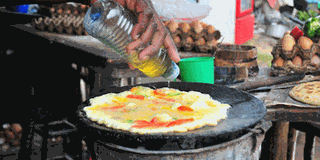Rolex; Made in Uganda

You can find a filling meal in a few minutes with a Rolex which comprises chappati, eggs and it could also have other ingredients like minced meat, sausage, vegetables among others. File photo.
What you need to know:
This seemingly simple cuisine has become a big part of the culture in suburbs in Uganda especially in Kampala’s Wandegeya, Nakulabye and Kabalagala. It is often a savior meal for many a University student and bachelor
In Uganda and especially in the outskirts of Kampala other big towns and trading centres, one would be forgiven for thinking that the word “Rolex” has anything to do with the famous Swiss watch brand. Nothing could be further from the truth. A Rolex is a rolled chapatti with eggs and for many years has become the favourite food for university students and bachelors. Renowned areas for the trade in Rolex are Wandegeya, Nakulabye and Kabalagala.
My first encounter with it came about during the time when I had an interest in a fast-food joint in Wandegeya along with a buddy of mine which proved to be short lived. Around 2003, a man called Sula sought my view on the idea of selling chapatti with scrambled eggs as a combination. He had been in business for a while, but as is often the case in Uganda, he was underfunded and greatly lacked exposure not to speak of business acumen.
The fact that I was a food critic was no doubt one of the reasons for him making my acquaintance though I am not so sure whether this was of any help in his quest to expand.
While I welcomed the idea, I remembered the Jamaican rotis that James B’s used to make in the Bronx, New York during the 60s. The idea of the roti was a chapatti rolled and filled with any number of savory food items ranging from chick peas, curry goat, chicken to mixed vegetables, minced meat was bound to be a winner.
Sula’s invention was novel (though by no means original) in that for Shs500, one was able to get two scrambled eggs and a chapatti. No doubt the product was perfectly priced for the average coed and was an instant success. The Rolex became very popular amongst the Makerere campus crowd, and not only became the favourite eating item for all and sundry, but many variations were created from the original. During those days a Rolex would come with the works; things were a lot cheaper than today. Nowadays, one is lucky to get more than a couple of eggs and a smidgen of an onion and tomato and the going rate is around Shs1,200 though in some areas the price could be higher.
I know of a café in town that touts a super Rolex that includes shredded cabbage, tomatoes, green pepper, cilantro, chilies, minced meat or shredded chicken and home fried potatoes. Filling and substantial, it does not come cheap.
Interestingly, no great culinary skill is required for one to learn how to make chapattis. This is the sort of cooking that one invariably learns on the job and fortunately does not have any requisite skill such as would be expected from the makers of naan or rotis. Of course one has to have tremendous brawn and stamina and not surprisingly, very few women make chapattis on a commercial scale.
Chapattis are common and for a minimal investment of rent, a sigiri, griddle and some charcoal, flour, water and salt the rest is easy. Offhand, with a startup capital of Shs50,000, many a youth find it a good way to manage to make ends meet during these trying times.




